News and Events
We love to hear about your experience and see your photographs through the seasons. Don't forget to follow us on Facebook and share our pages. We know we've done a great job when you've had a fantastic day out!
Natural England Webinar on Climate Change and Biodiversity
Natural England are running 4 free webinars about the impact of climate change on biodiversity from next Tuesday. You need to register via the link below to join in
Link to Natural England Webinar
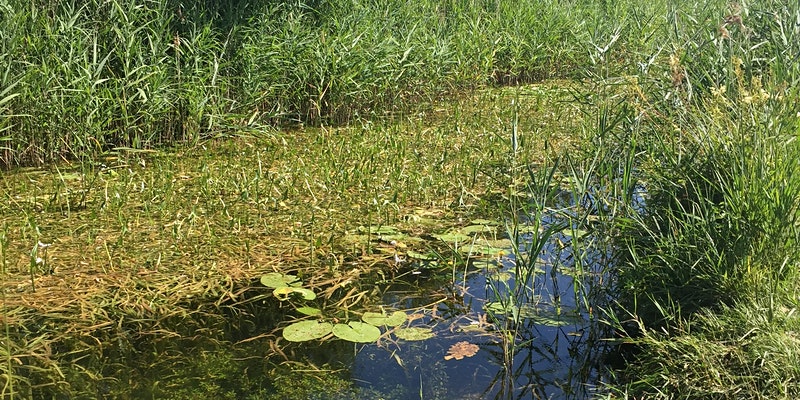
Garden Wildlife Activities and Surveys

Lindsey Wakefield's excellent guide to garden activities and surveys can be downloaded by clicking on the link below
If you are interested in joining BCA's Biodiversity Group then please contact us using the link below.
Mark Cocker talk to Buxton Field Club
Mark Cocker will talk to Buxton Field Club on 15th November at 7.30pm about Re-wilding

A date for your diary: Friday 15th November MARK COCKER is talking about Re-Wilding at Buxton Field Club. Mark is an author, naturalist and environmental tutor, who writes and broadcasts on nature and wildlife in a variety of national media. In 2018 he released a new book Our Place (Cape), on the fate of British nature in the twentieth century, and completed 30 years as a Guardian country diarist.
His 11 other books include works of biography, history, literary criticism and memoir. They include Claxton: Field Notes from a Small Planet (2014) and Birds and People (2013). The latter was published to international acclaim and was a collaboration with the photographer David Tipling.
Time: 7.30-9.30pm
Place: Buxton Methodist Church Hall, Chapel St, Buxton
Free to members, 18-25s, accompanied minors. £3 all others. Everyone is really welcome.
Biodiversity Group inaugural meeting
7.00 pm Tuesday 10th December 2019 at Poole's Cavern Visitor Centre
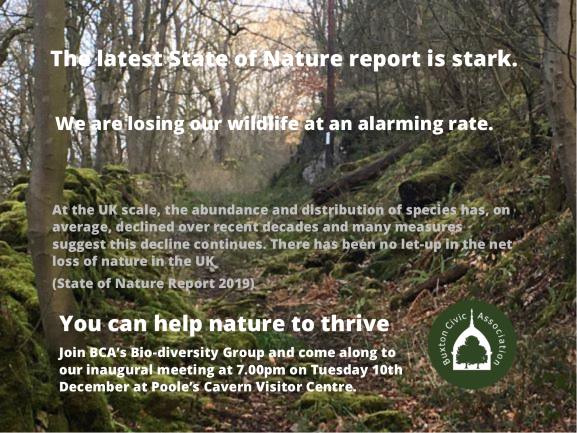
Everywhere nature is under pressure, and Buxton is no different from the rest of the country. As the pressure for more housing and roads increases the landscape becomes more and more fractured making it harder for flora and fauna to thrive and survive.
We need to take action to reverse this decline and it falls within the remit of BCA to take the lead on this. We have demonstrated our stewardship of the beautiful woodlands that we own but we need to look outside our own estate and bring together all the wonderful, dedicated hardworking groups in the town that care for and look after nature.
There is a need for a dedicated grouping to bring these concerned individuals and groups together and to attempt to address these important issues in the town. We have had informal liaison with the Buxton Field Club (a group of naturalists concerned with the study of natural history in and around Buxton) and several BCA members who share this concern. They agree that it would be helpful and valuable for BCA to create a group to fulfil this role.
Some of the immediate issues of concern are;
• the future management of the Nestle landholding at Lightwood
• the management of Fernydale Local Nature Reserve (adjacent to our Sherbrook Wood)
• the County Council land at Solomon’s Temple
• the management of wildflower areas at the Serpentine
• conservation of the important, highly threatened breeding population of Curlew and Lapwing in the immediate vicinity of Buxton
• the management of Cowdale Quarry
• the management of road verges
• spread of tree diseases in the town
• the conservation of breeding populations of swifts, martins, swallows and bats that use buildings in the town
• the conservation of wildlife on brownfield sites in the town
Many of these issues involve liaison, potentially lobbying and, hopefully, partnership working with other organisations (e.g. Nestle, High Peak Borough Council, Derbyshire County Council, Derbyshire Wildlife Trust and RSPB).
If you are interested in being part of the Biodiversity Group email us at;
We are holding an inaugural meeting at Poole’s Cavern on Tuesday 10th December 2019 at 7.00pm.
If you are interested in coming along it would be helpful if you could let us know at communications@buxtoncivicassociation.org.uk
Doing their Bit for Nature
Anna 13 and Izzy 10 raise £50 to help Friends of the Earth Save the Bees Campaign selling delicious homemade cup cakes at Poole's Cavern Visitor Centre




BCA Planning Group – comments on Nestle Pipeline
Background to Planning Application
Buxton Civic Association (BCA) is a registered charity established to preserve Buxton’s natural and formal landscape. The Association has a large active membership from the local community.
BCA is commenting on the planning application for the installation of a water pipeline from Rockhead Spring to the Nestle Plant, Buxton, HPK 2019/0097. It is understood that a trench 600mm wide and 1200mm deep will be excavated to install two 65mm stainless steel pipes and two 150mm ducts for power and data lines.
Comments
BCA notes that there is a current licence in place for water abstraction from Rockhead Spring. The licence, which is valid until 2030, allows for up to 175,000 m3 per year to be abstracted in accordance with the requirements of the abstraction license issued by the Environment Agency.
Bowland Ecology Ltd has undertaken an arboriculture and ecological appraisal, along the line of the route from the spring to the plant. This has involved an evaluation and assessment of the route identifying potential areas of impact and mitigation measures to be adopted. At this stage it is not known whether the assessment meets the requirements of Natural England.
The majority of the route follows existing paths/tracks, verges and semi-improved grassland. However the pipeline route passes through 125m section of the Peak Dales SAC following the route of a footpath that may also be an old vehicular route with a field gate. The woodland, Pigtor Wood, is a designated SSSI and forms part of the SAC. It is noted that a section also passes through a small section of Cunning Dale South LWS and two HPIs.
BCA has visited the site, reviewed the geology of the proposed route (this summary report can be provided on request) and considered some potential aspects relating the pipeline.
BCA has the following comments to make:
1. None of the documents supporting the planning application state whether any alternative, less environmentally sensitive routes have been considered for the pipeline;
2. Natural England and Derbyshire Wildlife Trust are both consultees to the planning application. BCA will rely on the statutory consultees to comment on the ecological aspects of the proposed route and whether planning permission should be granted and any mitigation measures to be adopted;
3. Method Statement – a detailed method statement for any ecologically sensitive areas and for protecting small mammals from becoming trapped in the trench should be prepared prior to any works commencing;
4. Japanese Knotweed/invasive species – to minimise any potential issues arising from the presence of such species it would be appropriate for the landowner or contractor to identify, treat and destroy prior to works commencing to minimise the potential for spread following construction works;
5. A qualified ecologist and wildlife expert (e.g. badgers) should be present on site during any works being undertaken in areas designated as being environmentally sensitive to oversee and ensure any ecological/wildlife impacts are minimised;
6. No excess excavation materials from trenching should be disposed of on site in any designated sensitive areas and in accordance with the requirements of Natural England;
7. Consideration should be given to establish depth to bedrock and whether it will be possible to construct a trench along the line of the path in Pigtor Wood and other areas given the shallow soils with bedrock. Where the pipeline installation occurs in areas of no exposure, it would be helpful to sample the rock (including orientation data) at intervals to confirm the geological mapping of the area. Samples might be sent to the British Geological Survey;
8. At the top of Ashwood Dale, the line of the pipeline follows a path to the A6. On the east side of the path there are outcrops of the Woo Dale Limestone and at the lower part of the path the Woo Dale Dolomite. One outcrop shows a clear contact between massive bedded (dolomitic?) limestone and a finely bedded calcilutite, typical of the Woo Dale Limestone Formation. This contact and its structural information should be preserved.
Link to Planning application documents on HPBC Portal
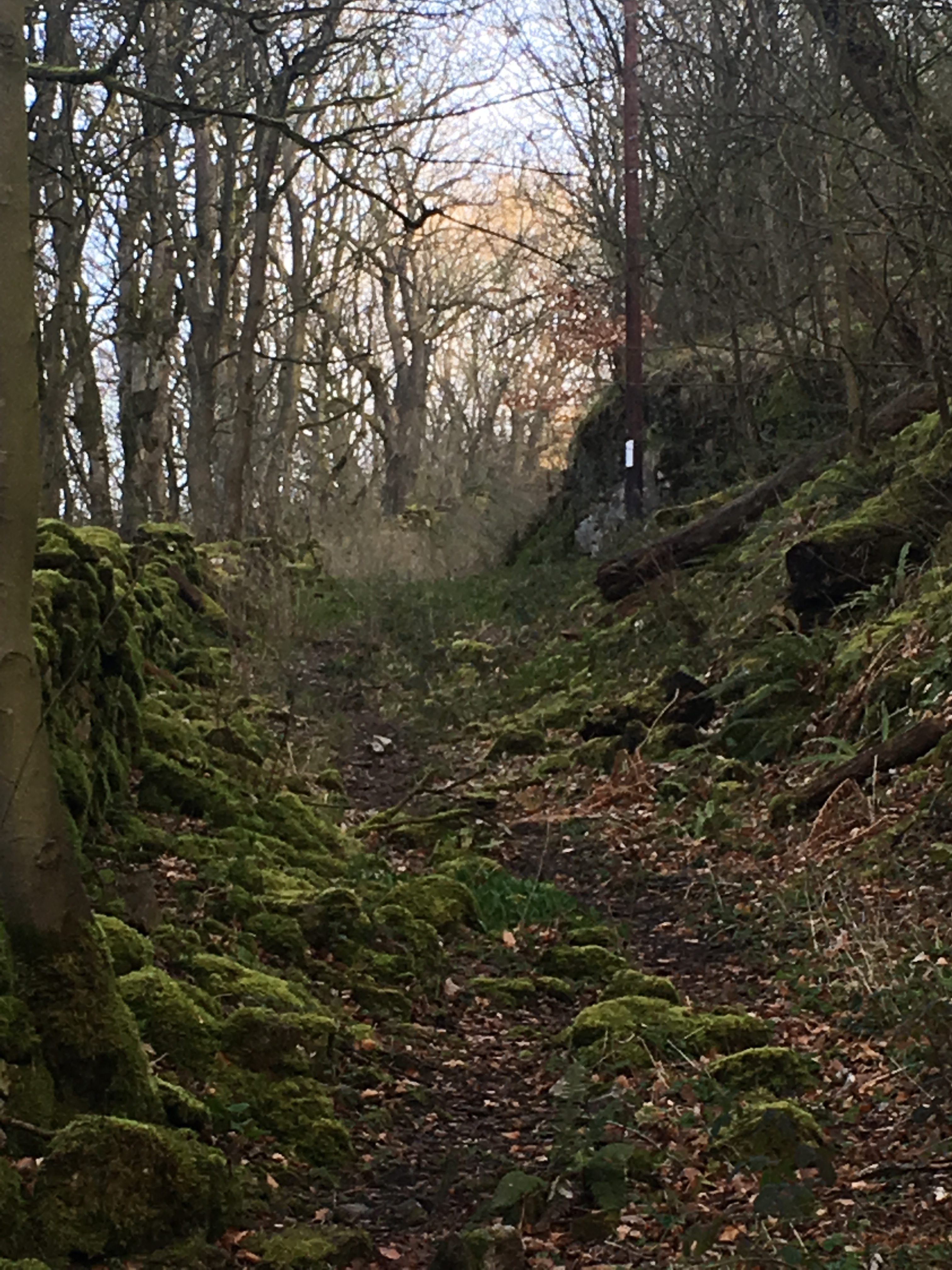
Proposed route of pipeline near Pigtor woods
Natural Heritage of Buxton: Geology
Professor Richard Pattrick on Fairfield Road's Carboniferous Corals
An outcrop of limestone on the east side of Farfield Road, Buxton (Fig 1) displays an excellent example of Carboniferous corals. The outcrop at [53°15'40.56"N 1°54'19.55"W] is a 3m vertical section, 25m long, set back 20m from the road.
The rock is the Eyam Limestone, of the Late Brigantian sub-stage (CX)(P2) of the Visean, Mississippinian stage of the Carboniferous. It is a dark grey limestone with distinctive chert bands (BGS Lexicon, 2019).
The coral is Siphonodendron junceum (Aretz and Nudds, 2005) – Order: Rugosa; Family: Lithostrotionidae. It is a reef build up, colonial rugose coral. This coral is displayed in transverse and cross sections of large (40cm) colonial masses (Fig. 2).
The importance of the site is that it is an excellent example of a colonial coral, easily seen over a long stretch of outcrop.
References.
M. Aretz and J. Nudds. 2005. The coral fauna of the Holkerian/Asbian boundary stratotype section (Carboniferous) at Little Asby Scar (Cumbria, England) and implications for
boundary. Stratigraphy 2(2):167-190. https://www.bgs.ac.uk/lexicon/lexicon.cfm?pub=EYL
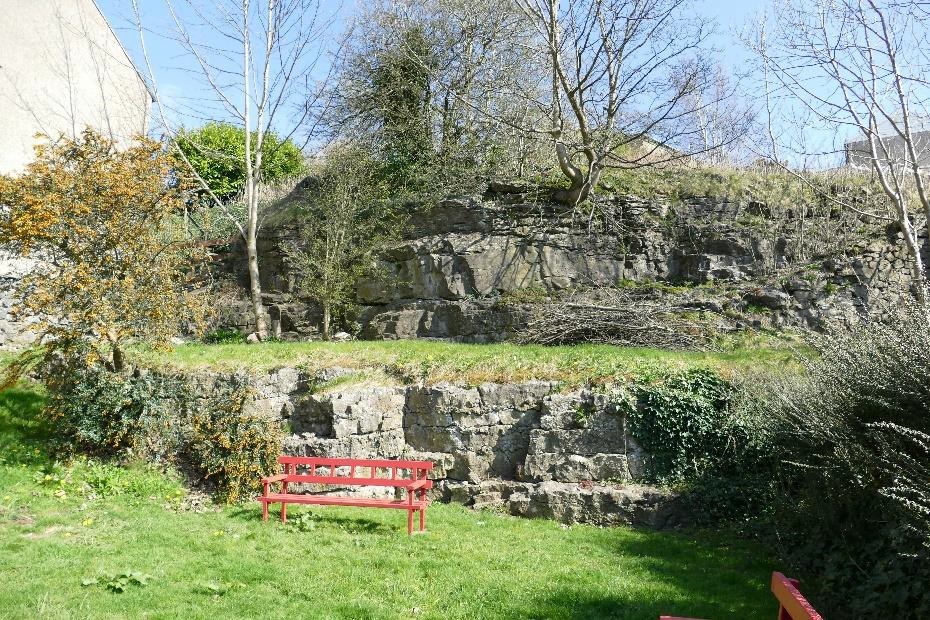
Fig 1 Outcrop of coralliferous, Carboniferous Limestone on the east side of Fairfield Road, Buxton
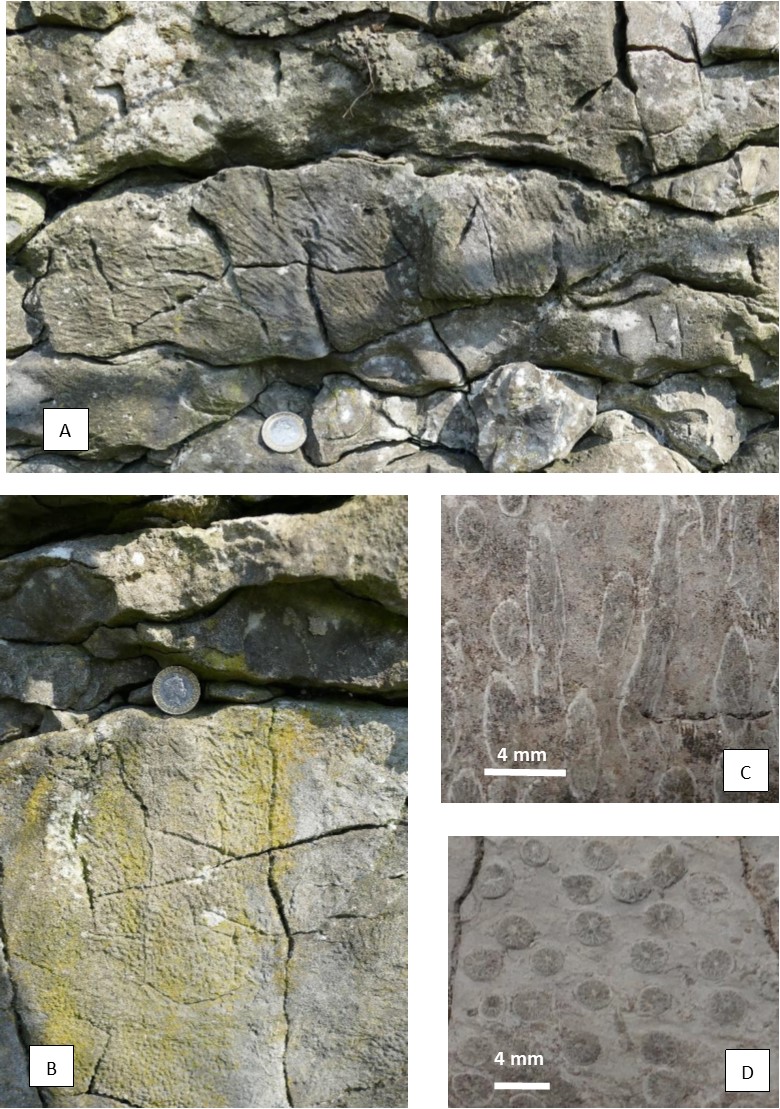
FIG 2 A & B) Colonial masses of S. junceum C) Oblique section of S. junceum D) Cross section of S. junceum. All Farfield Road site.
September Members Talk
A Vision for the Uplands with Dr Tim Birch Director and head of Living Landscapes at Derbyshire Wildlife Trust
‘A Picture is worth a thousand words’ so says the well know English idiom. And this was amply illustrated by Dr Tim Birch, a Director and Head of Living Landscapes at Derbyshire Wildlife Trust, at his recent talk titled ‘A Vision for the Uplands’ where he spoke to 60 members of Buxton Civic Association at their September Members meeting.
Tim put a picture on the screen of a chunk of Welsh hillside. The hillside was divided by a fence that ran from the road up to the rocky cliff top. To the left was the usual sheep grazed scene, shorn of all but the shortest grasses, bare, and barren.
But on the right hand side, protected as it had been from the sheep, the picture was staggeringly different. The hillside was a riot of small trees, birch, rowan and juniper and blackthorn bushes.
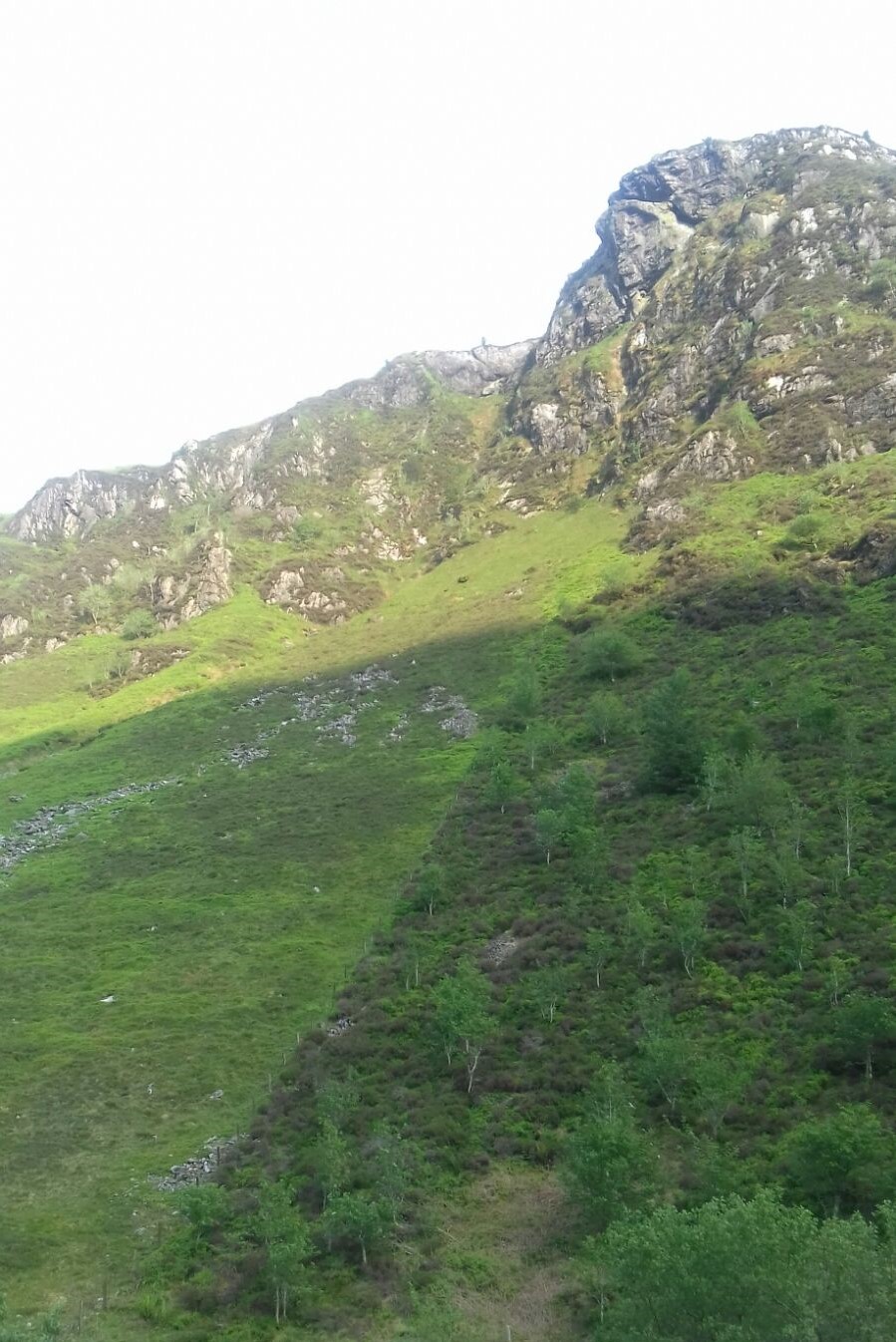
Who built the fence? Tim had yet to find out, but the message was clear. Give nature a chance and she will restore and recover damaged landscapes. And once the landscape is restored wildlife will find it and move in.
Knepp Estate a 3,500 acre ex arable farm in Sussex is proof of this. Tim had led a team from Derbyshire Wildlife Trust in the early summer to see the pioneering and inspiring work that Charlie Burrell and his wife Isabella Tree have done in wilding their farm.
Just two examples illustrate their success, Nightingales have declined by 90% since the 1970’s across Southern England but have found Knepp and are making it a stronghold, the Emperor butterfly is flourishing there and the early morning air is full of bird song. Tim and his team were astonished and moved by the dawn chorus.
The vision for the uplands is to achieve something similar on a landscape scale for the Peak District.
To enable the landscape to recover and heal itself, to encourage once common species such as Pine Marten and red squirrels to return and thrive. And to provide a wonderful place for us, our children and grandchildren to learn about and appreciate the natural world all around us.
But to do this, to achieve this vision, will require a landscape scale solution.
Tim talked about the isolation of the Derbyshire Wildlife reserves, surrounded as they often are by grouse moors and shooting estates with their traps and snares. The reserves become little refuges for nature but on too small and too fragmented a scale.
A good example of this is the Lady Bower Woods Reserve. The picture below illustrates the point. To the left of the stone wall is the Moscar Grouse Moor, to the right the DWT reserve.
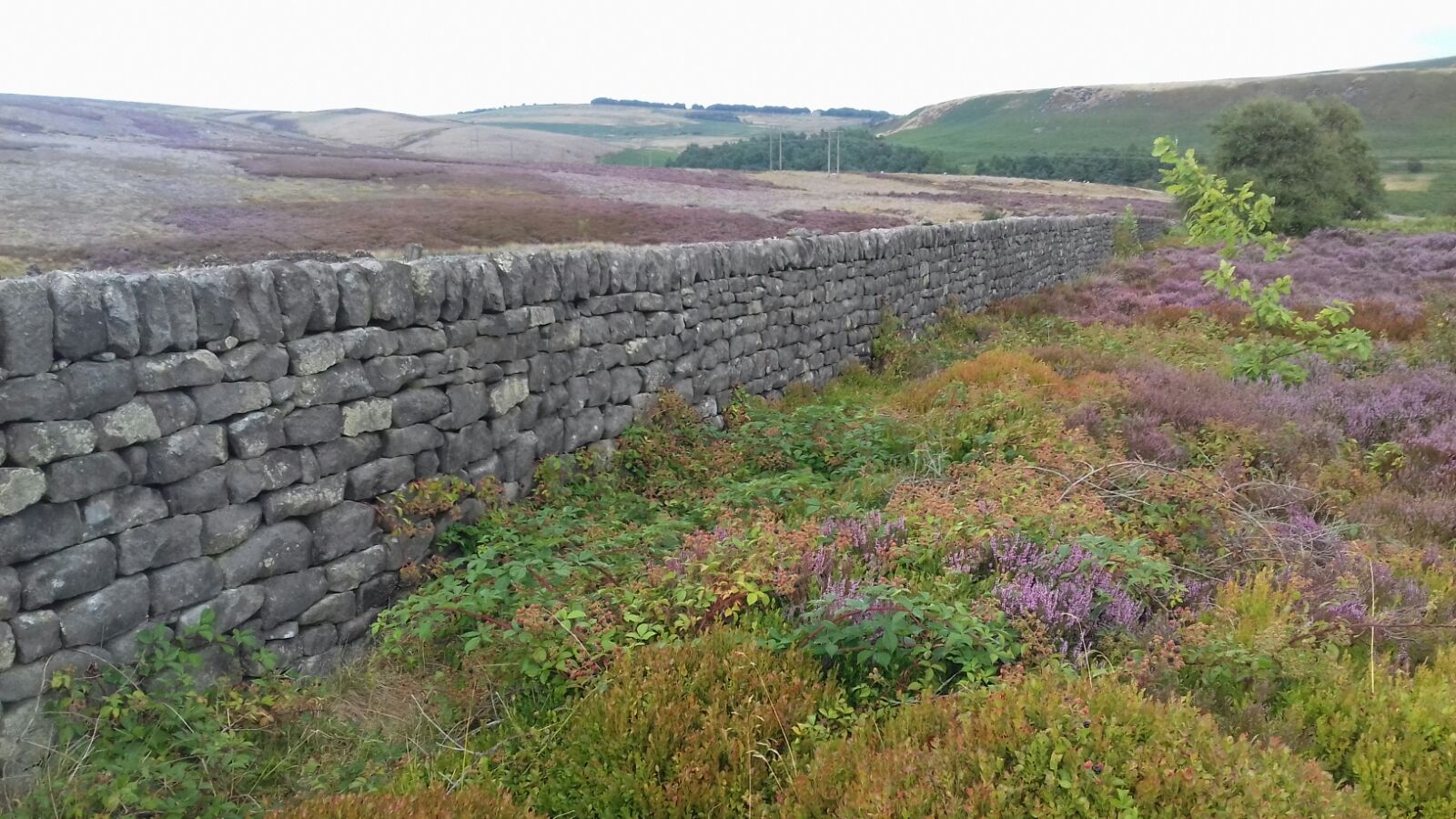
But create a landscape wide approach and then these reserves become isolated no more, but become vital hot spots of wildlife that can then spread out into the wider landscape.
Of course it will all take time. There are a multitude of landowners and stakeholders to consult with and bring on board. But things are changing. Almost daily there is news of new initiatives and schemes, the recent ‘Summit to Shore’ rewilding project in Wales and the plans to restore the Caledonian Forest in Scotland to name but two.
And with the drive and vision of Derbyshire Wildlife Trust and all the other wildlife groups including the work that Buxton Civic Association is doing to create woodland habitats that encourage greater biodiversity, then a grand plan for the Peak District will not be far behind.
One day soon perhaps there will no need for a fence and we can learn how to let nature survive and thrive alongside us.
A Peak District teeming with wildlife, with wildflowers and trees and scrub, where bird song and the hum of insects is taken for granted again, and who knows what might be lurking in the undergrowth or surprise you round the next corner in the forest.
That is some vision, and some picture. It is something worth working for.
Links to the Derbyshire Wildlife Trust Website and others below
BCA Walking Guide – Quarries and Kilns

Our latest walking guide is now available from Poole's Cavern Visitor Centre, price £2.50. Written by Lyn Noble it takes you on a journey to uncover the story behind 300 years of lime burning around Buxton. Ideal for individuals, groups or families.